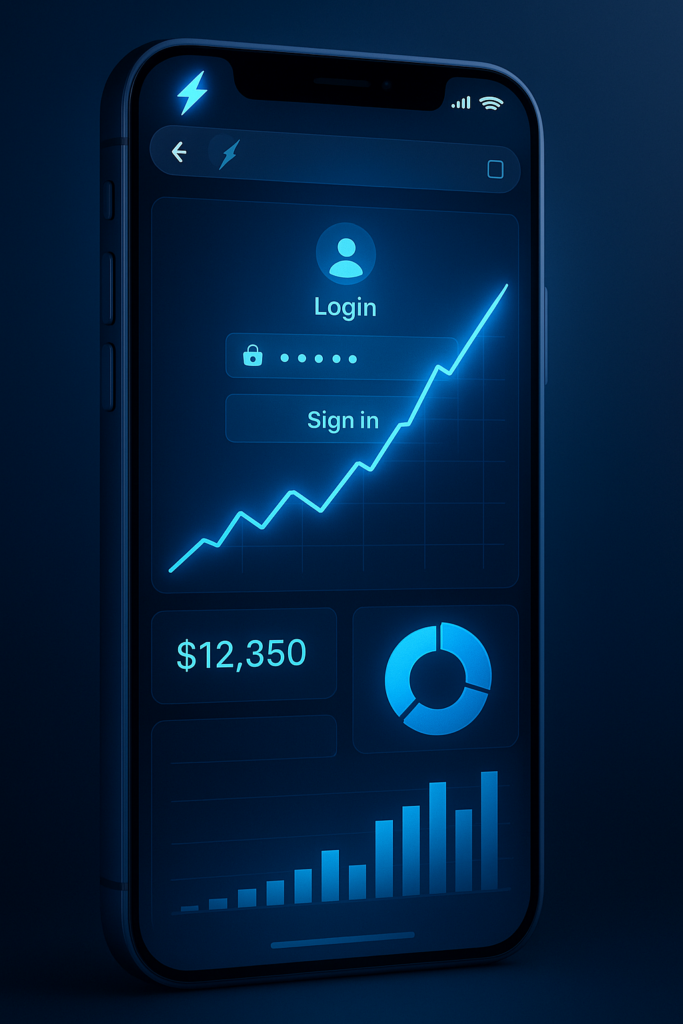The Future of Mobile-First in FinTech: Why PWAs Are Leading the Charge

Many users today hesitate before downloading a new app. They pause, check their phone’s storage, and wonder: is this really worth it? In the previous year, app downloads exceeded 218 billion, reflecting an approximate 7% growth compared to the preceding year. Thus, in a world flooded with apps, that split-second doubt is common, and it’s exactly what Progressive Web Apps are built to overcome.
Users want faster, lighter, and more secure experiences, without the hassle of app stores or constant updates. That’s where Progressive Web Apps (PWAs) come in, and FinTech companies should be paying close attention.
While tech giants like Uber, Starbucks, and McDonald’s have already embraced PWAs to streamline user experiences, the FinTech space is just beginning to realize the true potential of this technology. From mobile banking to peer-to-peer payments, PWAs offer the right blend of performance, accessibility, and security, without the friction of traditional apps.
This isn’t about chasing trends. It’s about staying relevant in an industry where milliseconds can cost millions, and user trust is everything.
What Is a PWA, and Why Should FinTech Care?
A Progressive Web App is a type of application delivered through the web that uses modern browser capabilities to offer an experience similar to native mobile apps. It works on any device with a standards-compliant browser, can be installed on the home screen, and supports push notifications, offline functionality, and background updates.
But here’s what makes them game-changing for FinTech:
- No app store gatekeeping
- Faster load times and smaller footprint
- Offline access
- Secure by design
- Updates seamlessly in the background
These capabilities aren’t just great specs on paper. They’re exactly what users in finance demand, instant access, secure transactions, and low-friction interactions.
Real-World Adoption: What Big Brands Are Doing with PWAs
FinTech isn’t the only vertical benefiting from this technology. Industry leaders across the globe have shifted away from native apps, or at least diversified with PWAs, to remove barriers and speed up the user journey.
- Uber: Developed a PWA for low-end devices or slower connections, enabling users to request rides with just 50kb of data and near-instant load times.
- Lyft: Offers a browser-based version of their app that mimics the native experience to reduce dependency on app store installs.
- Starbucks: Created a PWA that allows ordering and payment even when offline, which helped double the number of web orders.
- McDonald’s: Rolled out PWAs to enhance mobile ordering, especially in regions with unreliable data connections.
These brands have one thing in common: they understand that mobile friction kills conversions. FinTech companies, especially those in emerging markets, can learn a lot from this.
Why Progressive Web Apps Make Sense in FinTech
FinTech users expect intuitive, snappy, and secure interfaces. PWAs cater to all three.
1. Seamless Integration
PWAs can integrate with modern APIs and tools, enabling agile deployment. However, in FinTech environments where back-end systems must meet rigorous security and compliance standards, integration planning requires additional diligence. You can launch a fully functional app-like interface on mobile and desktop, without rebuilding from scratch.
This allows FinTech teams to:
- Shorten development cycles
- Reduce reliance on platform-specific teams (iOS vs. Android)
- Make updates without disrupting user sessions
Imagine onboarding a user into your mobile banking app without forcing them to visit the App Store or wait for updates. That’s the power of a PWA.
2. Offline Capabilities
Many FinTech apps require at least some offline functionality, whether it’s viewing account history, managing budgets, or queuing up a transfer. PWAs can cache data for offline access, allowing users to view previously loaded account information or dashboards. While full transactions and real-time updates require an internet connection, this offline resilience can still be valuable in regions with intermittent connectivity.
For countries with spotty coverage or where users frequently switch between data and Wi-Fi, this is a game-changer.
3. Security Enhancements
PWAs are served over HTTPS, ensuring encrypted data transmission, which is a foundational security layer.” and FinTech could benefit from this foundational security layer. But that, of course, “FinTech companies must still implement robust compliance frameworks and server-side protections to meet regulatory standards.
Additionally, service workers, which power background functionality in PWAs, can be configured to limit data exposure and reduce attack surfaces.
Security best practices like CSP headers, two-factor authentication, and secure session handling apply just as robustly to PWAs as they do to native apps, and they’re often easier to manage across platforms.

PWAs vs. Native Apps: What’s the Better Fit?
It’s not a competition, it’s about choosing the right tool for the job. When deciding between Progressive Web Apps (PWAs) and native apps for your FinTech solution, it’s important to evaluate the strengths and limitations of each approach based on your business goals and user expectations.
PWAs eliminate the need for app store downloads, which is a major advantage when reducing friction in the user journey. Unlike native apps, which require installation through app marketplaces like the App Store or Google Play, PWAs can be accessed instantly through a mobile browser and added to a home screen with a single tap. No downloads, no delays.
Platform dependency is another key differentiator. Native apps require separate builds for iOS and Android, often involving two different development tracks and added costs. PWAs, on the other hand, are inherently cross-platform. They work across modern browsers and devices, giving your FinTech brand a broader reach with less technical overhead.
Offline functionality is available on both platforms, but PWAs often handle this more gracefully through built-in caching and service workers. This is particularly useful in regions with intermittent connectivity, where FinTech users might need to check account balances or view recent transactions even without internet access.
Push notifications, a hallmark of native apps, are also supported by PWAs, especially on Android and increasingly on iOS. This narrows the engagement gap significantly and allows brands to maintain communication without a native environment.
From a storage perspective, PWAs are far more lightweight. Native apps can take up significant space on a user’s device, which may lead to uninstalls or hesitations in downloading. PWAs typically load quickly and don’t demand much storage, helping users engage without the performance hit.
Updates are another area where PWAs shine. Native apps often require manual updates or rely on background auto-updates that users can disable. With PWAs, updates happen automatically the next time the user visits the app, ensuring everyone gets the latest features without lifting a finger.
Finally, installation friction plays a crucial role in conversion rates. Native apps require multiple steps, searching, downloading, installing, and opening, before a user can even engage. PWAs streamline this into one click: users simply open a link and start using the app instantly.
| Feature | Native App | Progressive Web App |
| Download required | Yes | No |
| App store dependency | Yes | No |
| Cross-platform | No (iOS, Android separate) | Yes |
| Offline support | Partial | Yes |
| Push notifications | Yes | Yes (on Android, increasingly on iOS) |
| Storage size | Often large | Lightweight |
| Update process | Manual or auto | Automatic in background |
| Installation friction | High | Minimal (Add to Home Screen) |
What’s Next: Will PWAs Become the Standard in FinTech?
The answer isn’t binary. Native apps will always have a place, especially for highly interactive, feature-rich experiences. But the future is moving toward hybrid models, where PWAs complement or even replace traditional apps, especially for acquisition, onboarding, and lightweight functionality.
As Google, Apple, and other browser vendors continue improving PWA support (including better access to device hardware and notifications), the gap between native and web continues to shrink.
In the next few years, expect to see more FinTech brands:
- Launch PWAs as their default mobile experience for users without app downloads
- Use PWAs to test and validate new features before rolling out full-scale native updates
- Offer PWAs as backup access when the native app fails, crashes, or can’t be installed
For FinTech marketers and product teams, the lesson is clear: Don’t just build for mobile. Build for how mobile is actually used, lightweight, on-the-go, and without unnecessary friction.
Final Thoughts
PWAs are no longer an emerging trend, they’re a strategic advantage. In FinTech, where the stakes are high and the competition fierce, delivering secure, fast, and accessible mobile experiences can be the difference between a user signing up, or bouncing.
By combining the reach of the web with the engagement of an app, Progressive Web Apps offer FinTech companies a smarter, more inclusive way to grow, without sacrificing security or performance.